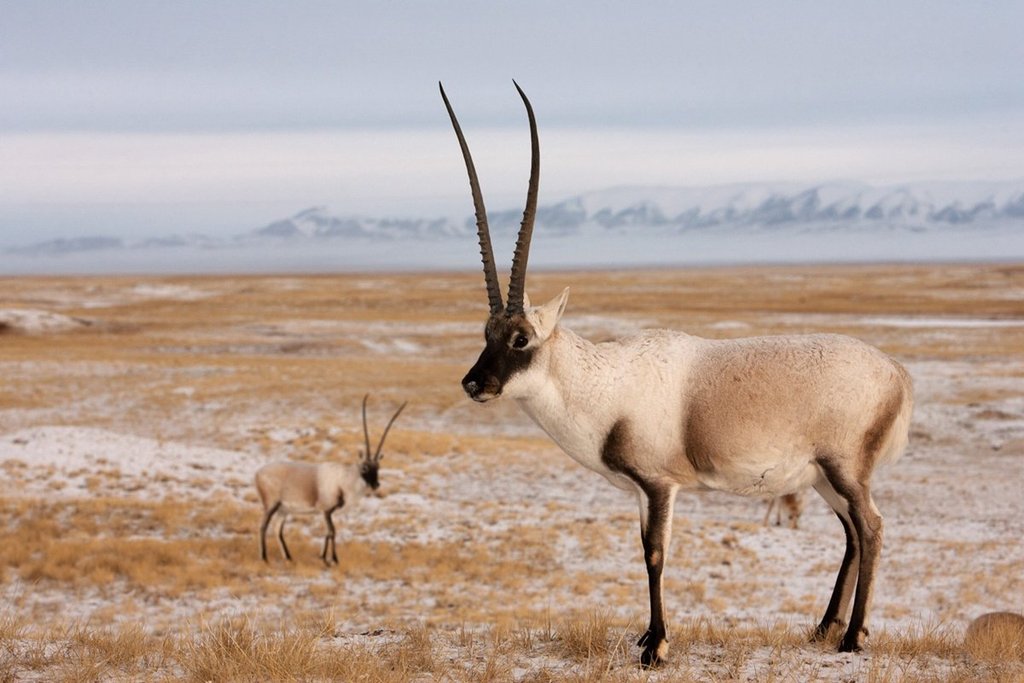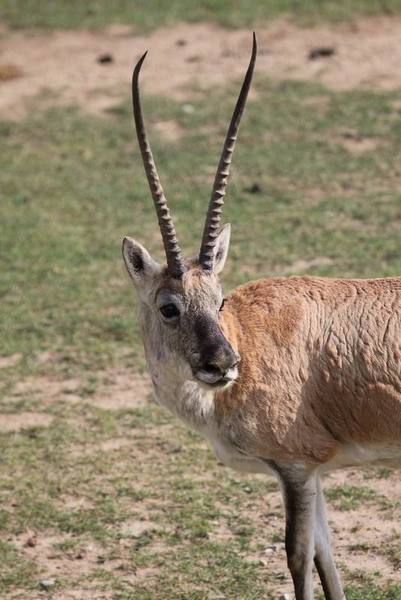Description
The Tibetan antelope possesses the softest and warmest wool in the world, incomparably delicate and matchlessly dense. Their fur is comprised of long guard hairs which vary from russet to a pale fawn in color. The belly is particularly woolly, either hoar or creamy white, and very velvety. The tufts of the undercoat are silky in texture, and noticeably shorter fibres.The head is darker, almost black, with bulbous nasal swellings. The Chiru’s nostrils have inflatable air sacs to enhance breathing at high altitudes, which leads to a swollen muzzle. The Tibetan antelope is lean and nimble. The ears are quite short, and pointed.
Males can be identified effortlessly by their slender, curved horns and the black stripes on their legs. These distinguishers are both absent with female Tibetan antelopes. The Chiru’s horns do not grow throughout their lifespans, but can reach up to 70 cm in length. A majority of the horns are ringed with prominent ridges until they taper back into a smooth, wickedly-pointed tip. Males are also substantially larger then females, weighting a hefty forty kilograms compared to around twenty-five or thirty.
Home
The Tibetan plateau, one of the most isolated and inhospitable places on the planet, is the Chiru’s exclusive habitat. The steppe that this bovid calls home is a cruel combination of hypothermic temperatures and a semi-arid climate. The vacant plateau falls in long, slow slopes and ridges which offer little protection from the penetrating mountain winds. The Tibetan antelope uses its cloven hooves to gouge depressions into the soil, procuring shelter from the wind and predators.
In decades past, the Tibetan antelope roamed a much more expansive territory. They are still occasionally spotted in the Qinghai and Xinjiang provinces, but have almost completely retreated into the ChangTang region of north-western Tibet, where their is a large wildlife sanctuary.
Occasionally the Chiru ventures as low as 10,700 feet, but more commonly dwells between 13,000 of 18,000 feet. Due to the elevation of the Tibetan plateau, the air is extremely rarefied. The anoxic environment of this hinterland is responsible for the sparse vegetation.
Diet
The Tibetan Antelope is a grazer and survives off a meagre diet of grasses, herbs, forbs, sedges, and shrubs. In the winter it is often necessary for the Chiru to dredge through the snow to find a meal. Herds chiefly feed during in the mornings and evenings, and rest sporadically throughout the day.
Predators
Extraordinarily vigilant and wary creatures, Tibetan antelope have hair-trigger alertness. At the first sign of a predator, the Chiru will bolt and be off like a bullet. Despite the thin air at such a high elevation, Tibetan antelopes are serious runners. The air sacs in their nostrils permit them to run up to eighty kilometres per hour, with unparalleled endurance. Their principle predators are wolves and snow leopards, and foxes with attack newborn calves.
Breeding and migration
Rutting season begins in November and will carry on through the winter. Courtship are brief and devoid of fanfare. Instead of actually sparring, male antelopes will simply intimidate each other through aggressive displays until one flees. The male’s coat will pale to match the snow and contrast with the dark markings on their faces and legs. They will form harems of up to twelve females, however, less fortunate Chiru’s must be satisfied with between one to four.
Tibetan antelopes are both nomadic and migratory, regularly covering vast distances as they wander between summer and winter pastures. Gestating females will travel north over three hundred kilometres to arrive at their traditional birthing grounds. Calves are delivered in June and July, after a six month pregnancy. The mothers will only produce a single offspring, and life expectancy for the newborn is startlingly grim. Calves are precocial, capable of walking within only fifteen minutes of birth and fully developed after fifteen months.
In late April or May, just as their horns have begun to emerge, juvenile males will separate from their mothers. These adolescent antelopes will band together and either remain in their winter grounds throughout the summer or roam the plateau. Young females often decide to stay with their mother until they themselves give birth. They will converge in the autumn, just in time for the annual rut.
Tibetan antelopes are extremely social animals, gathering in herds of usually a dozen or so individuals. It’s not strange however to hear of these herds numbering well up into the hundreds. Males and females always remain segregated, excluding the mating season. Solitary Chiru will drift alone across the steppe, dispersing the species widely thought the Tibetan plateau.
Shahtoosh
The underfur of the Tibetan antelope, or “soft gold” as it’s called by poachers, is the warmest and softest wool in the animal kingdom. Predominantly, this underfur is woven into a traditional shawl known as a shahtoosh. Mainly given away as an extremely expensive wedding present, prices for this shawl on the international market can skyrocket to as high as $40,000. For a single shahtoosh, between three to five antelopes need to be killed and harvested for their desirable, valuable underfur.
Tibet has experienced an illegal hunting epidemic that, over the course of two decades, almost resulted in the Chiru’s extinction. As a ramification of this unrestrained poaching, the Tibetan antelope population is estimated to have dropped by over 50%. There is calculated to be less than 75,000 remaining antelope left on the Tibetan plateau.
In addition to poaching, the Chiru must also contend with the annexation and development of their rangelands. Domesticated herds, the introduction of railways, and gold mining all contribute to the dwindling numbers of the Tibetan antelope.
The Chinese government employs rangers to patrol the sprawling expanse of the Tibetan Plateau. In China the Chiru is under second-class protection, but the species is also being safeguarded overseas. The Tibetan antelope was classified as endangered in the 2003 IUCN Red List of Threatened Species. The U.S. Endangered Species Act also prohibits shahtoosh products from being bought and sold within the United States.
The Tibetan antelope was honoured as the mascot for the Beijing 2008 Olympic Games.



